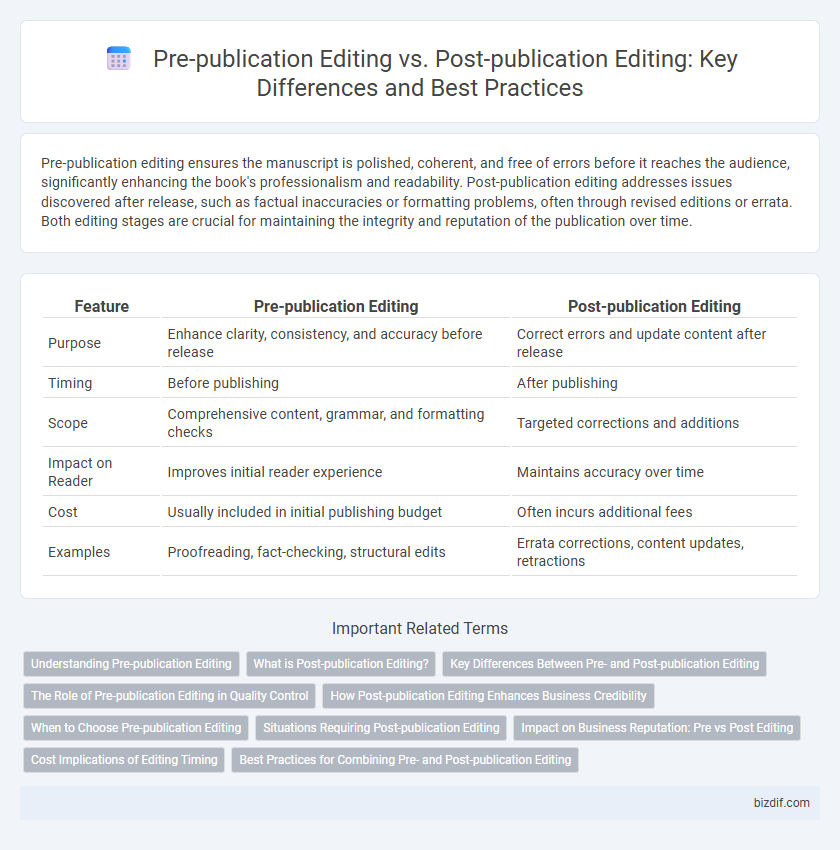Pre-publication editing ensures the manuscript is polished, coherent, and free of errors before it reaches the audience, significantly enhancing the book's professionalism and readability. Post-publication editing addresses issues discovered after release, such as factual inaccuracies or formatting problems, often through revised editions or errata. Both editing stages are crucial for maintaining the integrity and reputation of the publication over time.
Table of Comparison
| Feature | Pre-publication Editing | Post-publication Editing |
|---|---|---|
| Purpose | Enhance clarity, consistency, and accuracy before release | Correct errors and update content after release |
| Timing | Before publishing | After publishing |
| Scope | Comprehensive content, grammar, and formatting checks | Targeted corrections and additions |
| Impact on Reader | Improves initial reader experience | Maintains accuracy over time |
| Cost | Usually included in initial publishing budget | Often incurs additional fees |
| Examples | Proofreading, fact-checking, structural edits | Errata corrections, content updates, retractions |
Understanding Pre-publication Editing
Pre-publication editing involves thorough review and refinement of a manuscript before it is published, focusing on correcting grammar, improving clarity, and ensuring consistency in style and formatting. This stage enhances the overall quality of the content, making it more engaging and professional for the target audience. By addressing errors early, pre-publication editing minimizes the risk of costly revisions and reputation damage after release.
What is Post-publication Editing?
Post-publication editing involves making corrections, updates, or enhancements to content after it has been published online or in print, ensuring accuracy and relevance over time. This process addresses errors missed during pre-publication editing, incorporates new information, and adapts content to changing standards or audience needs. Effective post-publication editing maintains the integrity and credibility of published materials by continuously refining and optimizing the content.
Key Differences Between Pre- and Post-publication Editing
Pre-publication editing involves refining the manuscript for clarity, grammar, and consistency before the work is finalized and made public, ensuring error-free and polished content. Post-publication editing addresses corrections, updates, or retractions after the material has been released, focusing on maintaining accuracy and relevance in the published document. The key differences lie in timing and purpose: pre-publication editing aims to prevent errors before release, while post-publication editing manages ongoing quality control and factual accuracy once the work is accessible to readers.
The Role of Pre-publication Editing in Quality Control
Pre-publication editing plays a critical role in quality control by ensuring that manuscripts meet rigorous standards for accuracy, clarity, and consistency before release. This process includes fact-checking, grammar correction, and structural adjustments, which reduce errors and enhance the overall readability of the publication. By addressing issues prior to publication, it minimizes the need for costly post-publication corrections and preserves the author's credibility.
How Post-publication Editing Enhances Business Credibility
Post-publication editing allows businesses to continuously update and refine their content, ensuring accuracy and relevance over time, which builds trust with their audience. This ongoing process demonstrates a commitment to transparency and quality, key factors in establishing and maintaining credibility in competitive markets. By promptly addressing errors or outdated information, companies reinforce their professional reputation and customer confidence.
When to Choose Pre-publication Editing
Pre-publication editing is essential when the goal is to ensure clarity, coherence, and accuracy before the manuscript reaches the audience, reducing errors that could harm credibility. Authors and publishers prioritize this type of editing to enhance readability, correct grammatical mistakes, and align with style guides, which saves time and costs associated with post-publication corrections. Choosing pre-publication editing improves the overall quality and professional presentation of the work, preventing the need for extensive revisions after release.
Situations Requiring Post-publication Editing
Situations requiring post-publication editing often arise due to the discovery of factual inaccuracies, typographical errors, or emerging new information after the work has been released. Post-publication editing becomes crucial in academic journals, news articles, and digital content to maintain credibility, compliance, and up-to-date information. This editing process ensures corrections are documented transparently through errata or updates, preserving the integrity of the publication.
Impact on Business Reputation: Pre vs Post Editing
Pre-publication editing enhances business reputation by ensuring accuracy, clarity, and professionalism before the audience sees the content, reducing the risk of errors that could damage credibility. Post-publication editing, while useful for correcting mistakes after release, may result in perceived carelessness or diminished trust among readers due to initial oversights. Timely and thorough pre-publication editing is critical for maintaining a strong, positive business image and fostering customer confidence.
Cost Implications of Editing Timing
Pre-publication editing generally incurs higher upfront costs due to comprehensive content revisions and fact-checking before printing or digital release, ensuring quality and reducing future liabilities. Post-publication editing often involves lower direct expenses but can lead to increased costs related to issuing corrections, updates, or recalls, impacting reputation and reader trust. Strategic budgeting for pre-publication editing mitigates expensive post-release amendments and preserves long-term brand integrity in publishing workflows.
Best Practices for Combining Pre- and Post-publication Editing
Effective manuscript refinement involves integrating pre-publication editing to enhance clarity and consistency before release with post-publication editing to address reader feedback and emerging issues. Implementing a workflow that schedules thorough pre-publication proofreading alongside a responsive post-publication update process ensures ongoing content accuracy and quality. Leveraging specialized editing tools and collaborating with professional editors during both stages maximizes the publication's credibility and reader engagement.
Pre-publication Editing vs Post-publication Editing Infographic

 bizdif.com
bizdif.com